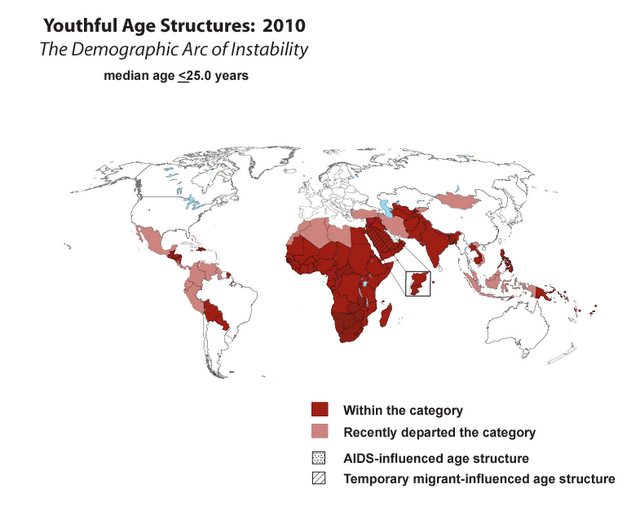-
‘Watch Live: September 2, 2010’ Integrated Analysis for Development and Security: Scarcity and Climate, Population, and Natural Resources
›September 2, 2010 // By Wilson Center StaffEnvironmental Change and Security Program
Thursday, September 2, 2010, 12:00 p.m. – 2:00 p.m
Woodrow Wilson Center, Washington DC
Event is invitation only. Please tune into the live webcast, which will begin at approximately 12:10 p.m.
Agenda Webcast
Alex Evans, Head of Program, Climate Change, Resource Scarcity and Multilateralism, Center on International Cooperation, New York University; Writer and Editor, Global Dashboard
Mathew J. Burrows, Counselor and Director, Analysis and Production Staff, National Intelligence Council (NIC)
Geoffrey D. Dabelko (Moderator), Director, Environmental Change and Security Program, Woodrow Wilson Center
Alex Evans thinks energy, climate, food, natural resources, and population trends are mistakenly considered separate challenges with a few shared attributes. He suggests instead that scarcity provides a frame for tying these sectors together and better understanding the collective implications for development and security. As a regular advisor to the United Nations and national governments, Evans will outline practical policy conclusions that flow from a focus on scarcity and integrated analysis.
As counselor and director of the analysis and production staff, Mathew J. Burrows manages a staff of senior analysts and production technicians who guide and shepherd all NIC products from inception to dissemination. He was the principal drafter for the NIC publication, “Global Trends 2025: A Transformed World,” the NIC’s flagship, long-range integrated analysis assessment that prominently featured natural resource, climate, and demographic trends. Burrows will share insights on producing and presenting integrated analysis for practitioners and policymakers.
Note: The live webcast will begin approximately 10 minutes after the posted meeting time and an archived version will be available on the Wilson Center website in the future. You will need Windows Media Player to watch the webcast. To download the free player, please visit: http://www.microsoft.com/windows/windowsmedia/download. -
Water, Power, Trash, and Security: Interview with Mishkat Al Moumin, First Iraqi Minister of the Environment
›August 31, 2010 // By Schuyler NullAs the final American combat brigade pulls out of the country, the prevailing opinion in the United States about Iraq at the moment seems to be one of “bad politics are better than no politics,” and that despite continued violence (albeit significantly lessened from 2006-2007 levels), the American mission is largely finished. However, serious challenges remain, one of the most significant being the government’s continued inability to supply basic services to a growing population.
-
‘NSB’ Blogs from the 2010 Global Maternal Health Conference in New Delhi
›The 2010 Global Maternal Health Conference kicked off today, perhaps fittingly, in India – one of the world’s fastest growing nations but one that also faces serious reproductive health challenges. The Wilson Center’s Calyn Ostrowski is in New Delhi for the conference and will be providing updates to The New Security Beat throughout the week.
Those interested can also find a schedule of events and list of participants on the conference website as well as live webcasted events on the main page. Stay tuned!
Photo Credit: “Mumbai, India, November 2009” courtesy of flickr user travelmeasia. -
The Complexities of Decarbonizing China’s Power Sector
›August 27, 2010 // By Wilson Center StaffOver the past year, there have been a series of new initiatives on U.S.-China energy cooperation. These initiatives have focused primarily on low-carbon development, and have covered everything from renewables and energy efficiency to clean vehicles and carbon capture and storage. Central to the long-term success of these efforts will be strengthening the U.S.’s incomplete understanding of China’s electricity grid, as all of the above issues are inextricably linked to the power grid itself.
As both the United States and China try to figure out how to decarbonize their power sectors with a mixture of policy reform and infrastructure development, China’s power-sector reforms could present valuable lessons for the United States. At a China Environment Forum meeting earlier this summer, Federal Energy Regulatory Commission (FERC) Chairman Jon Wellinghoff joined power sector experts Jim Williams, Fritz Kahrl, and Ding Jianhua from Energy and Environmental Economics (E3) to address the subject, discussing gaps related to electricity sector analysis and presenting research on decarbonizing China’s electricity sector.
Addressing Shared Challenges
Chairman Wellinghoff kicked off the presentation with an overview of the similarities and differences in the U.S. and Chinese power sectors. Wellinghoff stressed that both countries face common obstacles in expanding renewables, namely that wind- and solar-energy sources are located inland, far away from booming coastal cities where energy demand is highest. He added that market and regulatory incentives to integrate renewables into grids are currently insufficient.
However, Wellinghoff also made the point that each side has comparative advantages. For instance, while China has superior high-voltage grid transmission technologies, the United States has been developing advanced demand-side management practices and markets to spur energy efficiency and renewable integration in the power sector. Wellinghoff argued that mutual understanding of each others’ power sectors is important for trust-building and effective cooperation, and can result in net climate and economic benefits for both sides.
Achieving these benefits will not be easy. E3’s Jim Williams noted that the Chinese power sector is currently in transition, a process that is producing some increasingly complicated policy questions. How these questions are answered has the potential to drastically shift the outlook for China’s carbon emissions. For instance, if the United States can help push China’s power sector to become less carbon-intensive, there could be substantial benefits for lowering global greenhouse gas emissions.
One of the major issues at the moment is assessing the cost-benefit analysis of renewable and low-carbon integration and trying to ascertain what the actual cost of decarbonizing the power sector would be. Due to a lack of “soft technology” — analytical methods, software models, institutional processes, and the like — policymakers in China still do not have a good sense of what level of greenhouse gas reductions could be achieved in the power sector for a given cost.
More Intensive Research Needed
Fritz Kahrl and Ding Jianhua, also from E3, went on to explain that for China, as with the United States, the underlying issues of how to decarbonize the power sector will demand considerable quantitative analysis. The United States has more than three decades of experience with quantitative policy analysis in the power sector, driven in large part by regulatory processes that require cost-benefit analysis. In China, policy analysis in the power sector is still at an early stage, but there is an increasing demand among policymakers for this kind of information.
For instance, over the past five years, China’s government has allocated significant amounts of money and attention to energy efficiency. However, standardized tools to assess the benefits and costs of energy efficiency projects are not widely used in China, which has led to a lack of transparency and accountability in how energy efficiency funds are spent. This problem is increasingly recognized by senior-level decision-makers. Drawing from its own experience, the United States could play an important role in helping Chinese analysts develop quantitative approaches for power sector policy analysis.
Pete Marsters is project assistant with the China Environment Forum at the Woodrow Wilson Center.
Photo Credit: “Coal Power Plant (China),” courtesy of flickr user ishmatt. -
The Future of Sub-Saharan Africa’s Tentative Fertility Decline
›August 25, 2010 // By Richard CincottaIn her recent post on The New Security Beat, Jennifer Sciubba argues that the medium-fertility variant projection published in the UN Population Division’s biennial projections — the source of most future data published in the Population Reference Bureau’s 2010 World Population Data Sheet — forecasts an unrealistically low total fertility rate (TFR) for sub-Saharan Africa in 2050, at a rate of 2.5 lifetime childbirths per woman.
-
The Feed for Fresh News on Population
›August 24, 2010 // By Wilson Center StaffRT @NewSecurityBeat: New: Royal Society Calls for Submissions: “People and the Planet” Study – http://ht.ly/2oOju #Population @royalsociety
RT @NewSecurityBeat: New: #Land, #Education, and #Fertility in Rural #Kenya – http://ht.ly/2nvJL #Demography #Population #Youth #ECSP #fb
Spoke on need for integration in climate, food, water, & health on #USAID @PressClubDC panel. @NewSecurityBeat coverage http://ow.ly/2n0K4
Great to see Colin Kahl this morning. Here’s a @NewSecurityBeat podcast w/ him on environment, demography, & conflict http://ow.ly/2n0qG
My take on @Revkin on @dotearth asking how much is enough? Look to Durning & Pirages to help redefine the good life http://ow.ly/2mG2T
Follow Geoff Dabelko and The New Security Beat on Twitter for more population, health, environment, and security updates. -
“All Consuming:” U of M’s ‘Momentum’ on Population, Health, Environment, and More
›August 23, 2010 // By Schuyler NullMinnesota’s Institute on the Environment is only in its third year of operation but has already established itself as an emerging forum for population, health, and, environment issues, due in no small part to its excellent thrice-a-year publication, Momentum. The journal is not only chock-full of high production values and impressively nuanced stories on today’s global problems, but is also, amazingly, available for free.
Momentum has so far covered issues ranging from food security, gender equity, demographic change, geoengineering, climate change, life without oil, and sustainable development.
Highlights from the latest issue include: “Girl Empower,” by Emily Sohn; “Bomb Squad,” with Paul Ehrlich, Bjørn Lomborg, and Hans Rosling; and “Population Hero,” on the fiscal realities of stabilizing growth rates.
The lead story featured below, “All Consuming,” by David Biello, focuses on the debate over whether consumption or population growth poses a bigger threat to global sustainability.Two German Shepherds kept as pets in Europe or the U.S. use more resources in a year than the average person living in Bangladesh. The world’s richest 500 million people produce half of global carbon dioxide emissions, while the poorest 3 billion emit just 7 percent. Industrial tree-cutting is now responsible for the majority of the 13 million hectares of forest lost to fire or the blade each year — surpassing the smaller-scale footprints of subsistence farmers who leave behind long, narrow swaths of cleared land, so-called “fish bones.”
Continue reading on Momentum.
In fact, urban population growth and agricultural exports drive deforestation more than overall population growth, according to new research from geographer Ruth DeFries of Columbia University and her colleagues. In other words, the increasing urbanization of the developing world — as well as an ongoing increase in consumption in the developed world for products that have an impact on forests, whether furniture, shoe leather, or chicken fed on soy meal — is driving deforestation, rather than containing it as populations leave rural areas to concentrate in booming megalopolises.
So are the world’s environmental ills really a result of the burgeoning number of humans on the planet — growing by more than 150 people a minute and predicted by the United Nations to reach at least 9 billion people by 2050? Or are they more due to the fact that, while human population doubled in the past 50 years, we increased our use of resources fourfold?
Photo Credit: “All Consuming” courtesy of Momentum. -
Fire in the Hole: A Look Inside India’s Hidden Resource War
›August 18, 2010 // By Schuyler Null
Showing posts from category population.










